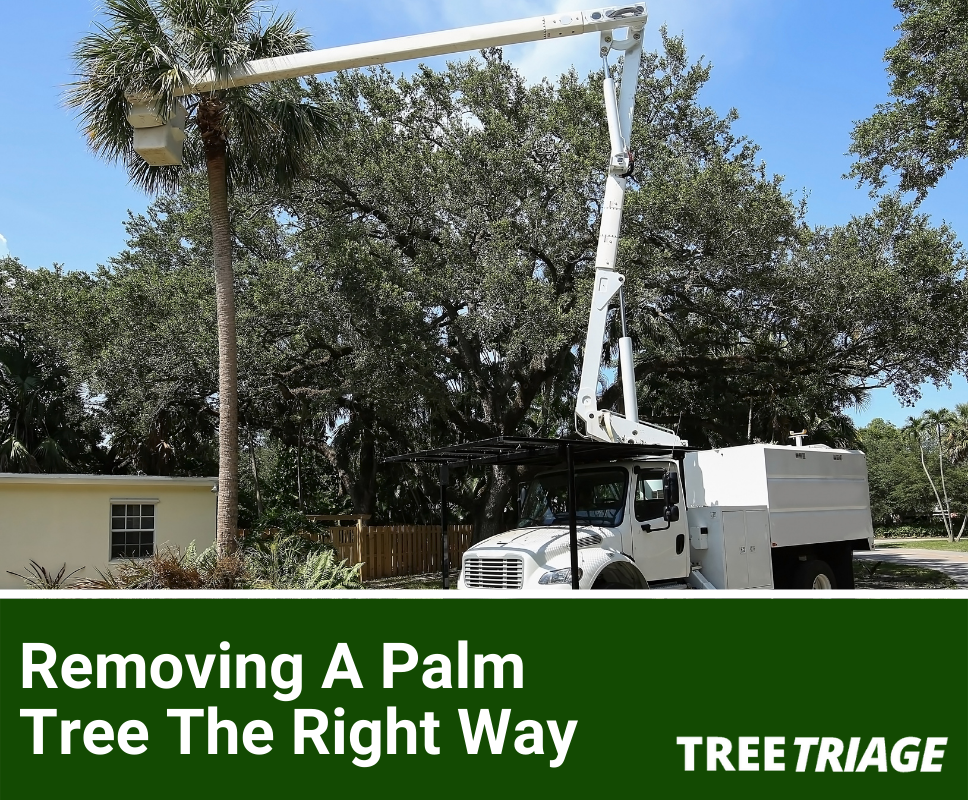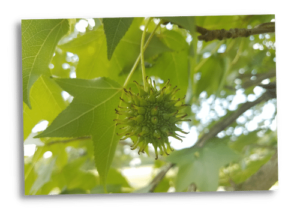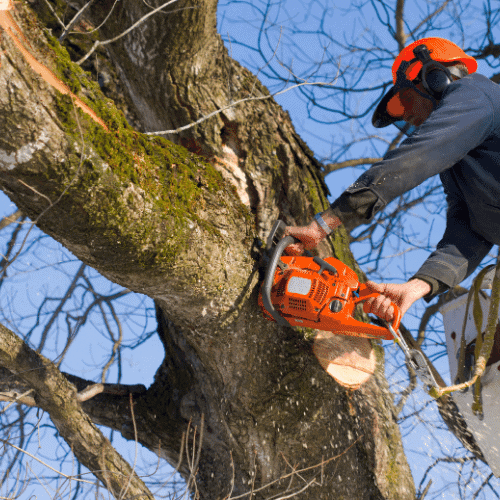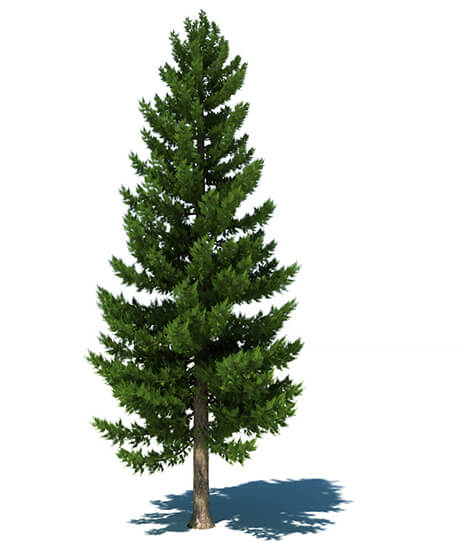Contents (Click To Jump)
- 1 When Does A Palm Tree Need To Be Removed?
- 2 Are Palm Trees Difficult To Remove?
- 3 What Is The Best Way To Remove A Palm Tree?
- 4 2 Methods Of Removing A Palm Tree
- 5 How Can The Palm Tree Stump Be Removed?
- 6 Will A Palm Tree Regrow From A Stump?
- 7 How Much Does Palm Tree Removal Cost?
- 8 When Should You Hire A Professional To Remove A Palm Tree?
When Does A Palm Tree Need To Be Removed?
The iconic palm tree is a valuable asset for many homeowners, from subtropical Florida to the arid desert regions of the southwest. However, this asset could easily become a liability for any of the reasons listed below:
- It has become diseased
- It has become infested by pests
- It interferes with your (or a neighbor’s) view
- The roots are causing damage to your property
- You want to build or plant something else in its place
But before you start up your chainsaw, there are several things to take into consideration in order to go about it safely and legally.
Are Palm Trees Difficult To Remove?

This depends of course on the size and type of palm tree you’re working with. The wood of a Mexican fan palms, for example, is lightweight and easy to cut through. Date palms and queen palms, on the other hand, have heavy, dense wood that is very fibrous.
Technically speaking, palm trees are not even trees, but rather “woody perennials,” according to the University of Texas at Austin. They do not behave like other trees when cut down, and controlling the direction in which they fall is more difficult.
Unless you plan on digging it up and transplanting it, another important consideration is how to dispose of the waste. Large palms will generate a surprising amount of biomass. Unlike other trees, the debris from palm trees cannot be chipped, and therefore has no value to landscapers.
Check with your local green waste recycling facility to find out if they charge an additional fee for palm debris.
What Is The Best Way To Remove A Palm Tree?
Without a doubt, the safest way to remove a palm tree is to call one of our professional tree removal services. If your palm is more than 12 feet tall, special equipment will be necessary — such as a harness and climbing spurs, or a hydraulic lift. These require training and experience to use safely, particularly if you will be using a chainsaw.

Relying on professionals will also pose less of a risk to your property. Your homeowner’s insurance may not cover damage caused by tree work. Our tree removal experts are fully insured in the event something unexpected does happen.
Depending on your location and the species of palm, a permit may be required for its removal. Our arborists can advise you whether or not a permit is necessary. Furthermore, some regions require trees above a certain height to be removed professionally for safety.
Examine carefully the surroundings of the palm tree. If there are power lines, buildings, or valuable plants nearby that could be damaged, you may want to reconsider before you take on the job yourself.
Finally, our tree removal services will haul away and dispose of all the debris.
2 Methods Of Removing A Palm Tree
There are 2 main methods you can use to safely remove a palm tree, each with their own advantages and disadvantages. Let’s dive into the details of these methods below so you can determine the best method for you.
Removing a Palm to be Transplanted
If your palm tree is small enough that you can move it with a few helpers, you may want to consider digging it up and replanting it.
Also, if you have a larger tree that you believe could be valuable, you might try to find a nursery or plant dealer willing to buy it. In this case, you will have to determine what species of palm tree it is. Check this site to identify your palm: palmidentifier.com
For information specific to palms in your region, here are some additional resources to use: The University of Arizona, The University of California, Aggie Horticulture (for Texas), and The University of Florida.
Another factor will be access. Make sure the tree is easily accessible from the street, and clear of power lines, as some heavy equipment may be needed to dig it up and load it onto a truck. Take a few photos that will indicate the species and scale of your palm, and send them out to local nurseries or plant dealers to see if there is any interest.
If you are going to handle moving the palm tree on your own, first step back and assess how you will go about it. Is there an open area where the tree can safely be lowered down? Is the palm leaning naturally in that direction?
If not, you will need to dig out around 24 inches of the soil around the tree’s roots, in the direction that you’d like your tree to go when it falls. Ensure the fronds will be free of power lines when the tree falls.
To prevent the palm tree from falling while you are digging it out, secure the trunk by staking it in four directions. Tie four lengths of rope about a third of the way up the tree, and then tie the other ends to four stakes pounded firmly in the ground.
The root ball of a palm tree is smaller than that of a regular tree. Depending on the height, it should be around two to three times the width of the trunk. Use your shovel to mark a circle around the tree, where you believe the outer edge of the root ball to be.
Dig down and gradually inward under the root ball, until the tree is freed. Use the blade of your shovel to cut through stubborn tree roots. Other tools that might be useful for cutting through the root system are a pruning saw, a hatchet, loppers, or a pick. Always have an escape route planned if your tree does start to fall.
Your tree is able to be lowered after its roots have been fully exposed. Ideally, you will have three helpers. Each can take up one of the ropes, and two can slowly pull to guide the tree, while the other two allow the tree to fall down as gently as possible. Make sure the ropes are long enough so that everyone can be out of the way as it falls.
Wrap the root ball in a burlap or vinyl tarp, and tie it up with rope. Now your tree is ready to be transported. Be sure to water the root ball thoroughly if you don’t intend to replant it right away, so as not to further stress your palm tree.
When replanting the tree, dig a shallow hole twice the size of the root ball, place the palm tree in it, and cover the exposed roots. Give it a long deep watering to thoroughly irrigate the root ball and surrounding soil. California Polytechnic State University recommends replanting palm trees at the beginning of the warm season.
Cutting Your Palm Tree Down

The very first step in a DIY palm removal is to check if you need a permit. This requirement may depend on the species of tree, it’s size, location relative to structures or power lines, and the area in which you live. So you will have to consult with local authorities.
Next, you will want to check your homeowner’s insurance. Make sure any potential tree-related damage that could occur to your property, or a neighbor’s, is fully covered under your policy.
It’s also a good idea to arrange for the disposal of the debris beforehand. As mentioned earlier, palm tree debris is not able to be chipped or burned, and not all green waste recycling facilities will accept palm. Make sure you find a facility that will take it, so you don’t end up with a yard full of palm debris.
If the above three steps are a go, you are now ready to tackle the job of felling your palm tree. Depending on its size, you will need some or all of the following supplies:
- A hand pruning saw
- Loppers
- A chain saw
- Ear protection
- Safety goggles, or a hard hat with a protective shield
- Protective chaps
- Gloves
- A reliable ladder
- A harness and flip line
CAUTION: It is beyond the scope of this article to instruct the proper use of a chainsaw. Chainsaws are extremely dangerous, and even seasoned professionals have accidents. We highly recommend you become familiar with safe chainsaw use before attempting to remove a tree. Oklahoma State University Extension provides this guide to get you started.
Evaluate the direction that your tree’s going to fall, and the trajectory. Walk around it and look at its trunk to discern its lean. Chances are good it will fall in that direction. Be sure your tree is clear of any power lines. You also want to make sure it’s not going to fall on vehicles, structures, or other plants.
Make sure that children and pets are not likely to enter the area during the operation.
If you’re unable to fell the tree in the direction that it’s leaning, you will need to tie a rope at least half way up the tree and make a wedge-shaped “pie cut” in the trunk.
Make your pie cut a couple of feet from the base of the tree, a third of the trunk’s diameter wide, and a third of the trunk’s diameter deep.
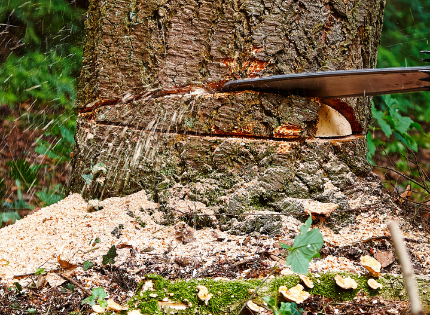
This cut will become the hinge upon which the tree will fall, so be sure it is angled properly in the direction you want it to go. Remember to tie the rope before making your pie cut, and be sure that it is long enough so that the person on the other end is well out of the trajectory of the falling tree.
Have your helper hold the rope somewhat taut, without pulling. Begin cutting from the side of the trunk opposite your pie cut. Begin cutting horizontally, a third of the way down from the top of your pie cut, and stop cutting about half way through the trunk.
Stand clear of the tree, and your helper should be able to gently pull the rope and bring the tree down. Don’t force the tree or cause the tree to sway, as it may fall in a direction that wasn’t intended. If the tree does not fall easily, make your cut slightly deeper and repeat the process.
If your palm is too tall to safely cut from the base, you will need to remove it in sections. Begin with the fronds. Beware, some palm fronds have spikes. If this is the case, it is best to wear thick gloves, goggles, a hard hat, and a long sleeved shirt to protect yourself while you prune away the fronds.
Rent a hydraulic lift, or tie a ladder to the trunk to stabilize it. It is also recommended to wear a harness with a “flipline” that can be “flipped” around the trunk and clipped back into your harness. This will prevent you from falling, and allow you to position yourself above the fronds to make your cuts. It is more difficult to cut through them from below.
Using loppers, pruning shears, or a hand pruning saw, cut the fronds as close to the trunk as possible, taking care not to get jabbed by any spikes. Move the ladder around the tree, and cut as many fronds as you can safely access.
Now you can begin removing the tree trunk in sections. Be sure to cut sections that will be easily manageable, so you don’t risk being injured. It’s best to tie a rope to a section and have a helper pull it away from you as you cut.
Before you make the final cut, consider what you intend to do with the stump. If you plan to dig it out, leaving several feet of trunk will give you some leverage for working it out of the ground. If you plan on removing it with a stump grinder, cut it as low to the base as possible.
While the tall palm in this video is obviously too dangerous for a DIY removal, it serves as a good demonstration of how a palm tree can be removed in sections.
How Can The Palm Tree Stump Be Removed?
You may decide to leave the base and use it as a pedestal to put potted plants on. However, if you want it removed, the easiest way is to rent a stump grinder.
The size of the stump grinder you can use will depend on the access to the stump. Be sure to measure the width of any doorways or gates you will have to pass through before you visit your rental shop. The smaller the grinder, the more difficult and time-consuming the stump grinding will be.
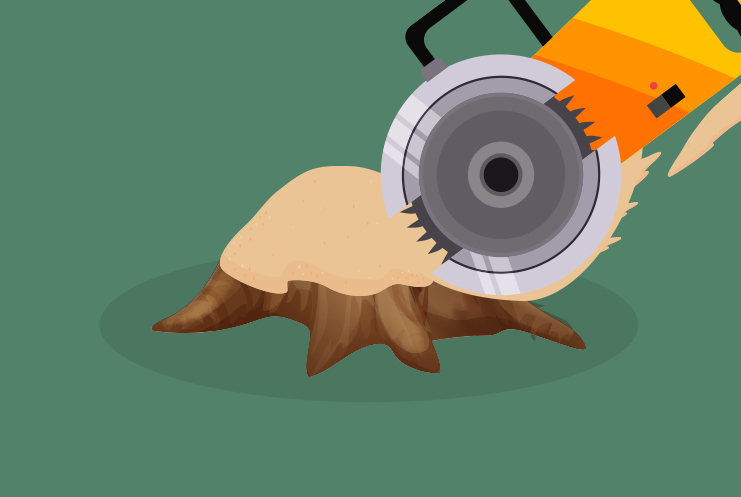
Some patience is required for tree stump removal. Go at it a little at a time, allowing the machine to do most of the work.
If the tree is relatively small, you may opt to dig the stump out by hand. Since palm trees have fairly fine roots, this is a bit easier than with other trees. Some tools that could be handy in cutting through stubborn roots are a pruning saw, a hatchet, loppers, or a pick.
Will A Palm Tree Regrow From A Stump?
Even if the entire stump remains in the ground, a palm tree lacks the ability to regenerate once its top has been removed.
How Much Does Palm Tree Removal Cost?
There is no exact formula to use when calculating the cost of palm tree removal. Below is a list of variables to take into consideration, however.
- Height and thickness of trunk
- Clearance of surrounding area and potential to damage structures and/or other plants
- Proximity to power lines
- Permits required
- Access from street
- Cost of disposal of debris in your area
- Whether or not you intend to remove the stump, and the size of stump grinder that can access the location
Assessing these various points should help you decide what actions to take when planning to remove your palm tree, and prepare you for some unanticipated costs.
When Should You Hire A Professional To Remove A Palm Tree?
As mentioned above, the safest, easiest, and perhaps most economical — depending on the value you place on your free time — way to go is by hiring one of our tree removal companies. They are equipped with the equipment and knowledge to get the job done safely and efficiently.
Removing a palm tree could end up being a much bigger task than you envisioned. And, if anything were to go wrong, it could easily cost you more than it would to have it done professionally.
Finally, unknown factors such as permits, insurance, and debris disposal would all be taken care of by people who deal with this kind of thing every day.

